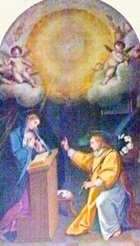

Cesare Nebbia, who was born in Orvieto, probably worked under Girolamo Muziano in the Duomo there in 1555-8. He is documented in Muziano’s workshop in Rome in 1562 and 1566 and probably spent much of the intervening period there. He then returned to Orvieto to begin his career as an independent artist.
Cesare Nebbia was centrally involved in the two major fresco decorations commissioned in Rome by Pope Sixtus V (1585-90): the decoration of the Cappella Sistina in Santa Maria Maggiore and the refurbishment of the Scala Santa at San Giovanni Laterano. He later worked extensively for Cardinal Federico Borromeo in Milan.
[He is thought to have executed the frescoes in three rooms of the palace at Torre San Severo, outside Orvieto that belonged to Cardinal Simoncelli in the late 16th century.]
Cesare Sermei (who also came from Orvieto) seems to have trained under Cesare Nebbia .
Orvieto
Works in the Duomo
Cesare Nebbia wrote to the Opera del Duomo in 1561, praying in aid his citizenship of Orvieto and offering his services in relation to the remodelling of the Duomo. This initiative was to bear fruit two years later.
Panels for the Sacramental Tabernacle (1563)
n 1563, Cesare Nebbia was commissioned to execute eleven panels for the new tabernacle for the consecrated host for the high altar of the Duomo. Raffaello da Montelupo had completed its design in 1558 and Ippolito Scalza had executed it in 1558-60. It had been installed on the high altar in ca. 1560 and gilded in 1563. The tabernacle, which was moved from the high altar to the back of the tribune in 1629, was destroyed in the late 18th century.
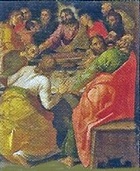
-
✴the miracle of manna in the desert;
-
✴the feast for the prodigal son;
-
✴Abraham's sacrifice of Isaac;
-
✴Melchizedek blessing of Abraham, when "King Melchizedek brought out bread and wine" (Genesis 14:18); and
-
✴the Last Supper (illustrated here).
Altarpieces (1569-75)
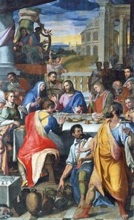
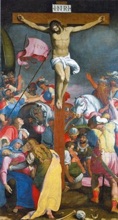
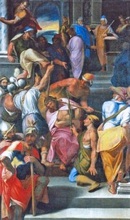
Marriage at Cana Crucifixion Crowning of Christ with thorns
Cesari Nebbia’s subsequent offer to work in the Duomo for only scant recompense culminated in a commission to execute the frescoes (1566) of the 1st chapel on the left. He was subsequently commissioned to paint its altarpiece (1567), which depicted Christ’s miraculous conversion of water into wine at the marriage at Cana. These commissions marked the start of his career as an independent artist. He restored his altarpiece of the marriage at Cana in 1572, after it had been damaged in some way. This probably completed the decoration of all the chapels in the left aisle.
Cesare Nebbia executed the frescoes of all five chapels on the right in the period 1572-7, working alongside the Florentine master of stucco, Ferrando Fancelli. He also executed two of their altarpieces:
-
✴the Crucifixion (1573-4), in the 5th chapel,; and
-
✴the crowning of Christ with thorns (1575), in the 3rd chapel.
The frescoes have been lost but the three altarpieces survive in Room V of the Museo del Opera del Duomo.
Birth of the Virgin (1582-4)
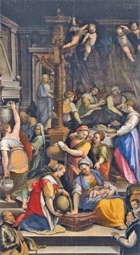
Cesare Nebbia was busy in Rome at this time, on work for Pope Sixtus V, and a number of surviving letters document successive delays with this commission. However, the altarpiece was extremely well received when it finally arrived in Orvieto in 1584. It was removed from the Duomo in ca. 1890 and is now in Room V of the Museo del Opera del Duomo.
Designs for Mosaics (1583-4)
Cesare Nebbia designed two new mosaics, which depicted the Baptism and the Resurrection of Christ, for the facade of the Duomo:
-
✴The heavily restored mosaic (1583) of the Baptism of Christ remains in situ, in the gable over the left door.
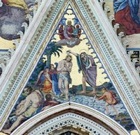
-
✴This cartoon (1584) by Cesare Nebbia for the mosaic of the Resurrection of Christ in the central tympanum was recently rediscovered and restored, and is now in Room IV of the Museo dell' Opera del Duomo. This scene was probably conceived as the finale to the series of scenes from the Passion of Christ in the altarpieces along the right wall of the church. Work on the mosaic itself extended over the period 1584-7, and Nebbia was still complaining in 1591 that neither he nor his collaborators had been paid for it, because of doubts about its stability. This mosaic was replaced in 1713 and subsequently lost.
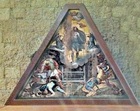
Christ and the Apostles (1611-12)
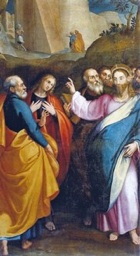
-
✴In the altarpiece that is still exhibited in the museum, Christ sends the Apostles from Jerusalem on missions of evangelisation.
-
✴The second altarpiece, which depicted Christ in the house of Simon, is too badly damaged to be displayed.
Works in San Domenico
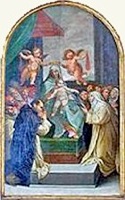
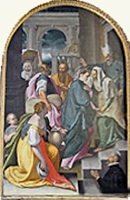
Madonna del Rosario Visitation
Two altarpieces in San Domenico are attributed to Cesare Nebbia:
-
✴The Madonna del Rosario (ca. 1575) on the left wall was commissioned for the altar of the Compagnia del Rosario. It depicts the Madonna and Child enthroned with SS Dominic and Catherine of Siena: the baby Jesus presents a rosary to St Catherine.
-
✴The Visitation (16th century) on the right wall was commissioned for the Missini family, to which the donor at the lower right presumably belonged.
Works in San San Francesco
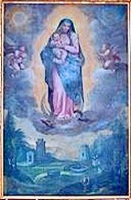
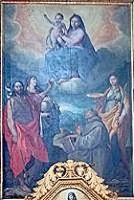
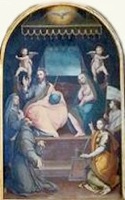
Immaculate Conception Madonna and Child in glory Entombed Christ with the Virgin
Three altarpieces in San Francesco are by or attributed to Cesare Nebbia:
-
✴the Immaculate Conception (1584) on the second altar on the left;
-
✴the Madonna and Child in glory with SS John the Baptist, Mary Magdalene, Lucy (with her eyes on a plate) and a Franciscan saint, on the third altar on the left; and
-
✴Christ in judgment, emerging from his tomb holding the world in his left hand, with the Virgin and SS Francis, Clare, George and Barbara, on the fourth altar on the left.
Works in Sant’ Andrea
-
✴the Annunciation (1586), in the first bay of the left transept, which came from the high altar of the Chiesa dell’ Annunziata (illustrated here); and
-
✴the Assumption of the Virgin (16th century), in the presbytery (which is sometimes alternatively attributed to Angelo Righi).
Frescoes in Palazzo Monaldeschi (1584)
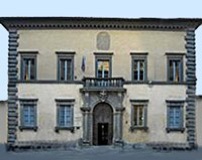
These frescoes on the first floor of Palazzo Monaldeschi, which were commissioned by Sforza Monaldeschi della Cervara, are attributed to Cesare Nebbia.
Frescoes in Palazzo Buzi (ca. 1585)
The frescoes that Vincenzo Buzi commissioned for the rooms of his new palace, Palazzo Buzi, are attributed to Cesare Nebbia and Giovanni Battista Lombardelli. they include:
-
✴the frescoes of two rooms on the ground floor, which depict allegories; and
-
✴those of a number of rooms on the piano nobile, which depict scenes from the Old Testament.
Perugia
Pentecost (ca. 1576)
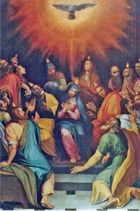
Spoleto
Capture of Christ (1574)
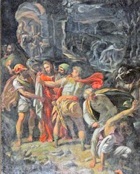
Read more:
A. Cannistra (Ed.), "Il Mosaico Risorto. Un Inedito di Cesare Nebbia tra Restauro e Valorizzazione", (2010) Orvieto
P. Tosini, “Il Duomo di Orvieto nella Seconda Metà del Cinquecento: un Modello per la Pittura della Controriforma”, in
C. Benocci et al. (Eds), “Storia di Orvieto: Quattrocento e Cinquecento” (2010) Pisa, Volume II (pp 469-88)
A. Satolli, “La Pittura dell’ Eccellenza: Prolegomeni ad uno Studio su Cesare Nebbia nel suo Tempo”, in
“La Pittura a Orvieto dal Rinascimento al Manierismo”, Bollettino dell ’Istituto Storico-Artistico Orvietano, 36 (1980) 17-252
R. Mack, “Girolamo Muziano and Cesare Nebbia at Orvieto”, Art Bull. 3 (1974) 410-3
